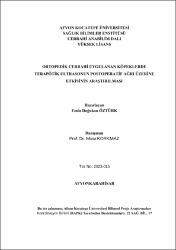Ortopedik cerrahi uygulanan köpeklerde terapötik ultrasonun postoperatif ağrı üzerine etkisinin araştırılması
Abstract
Bu çalışmanın amacı; çeşitli sebeplere bağlı olarak uzun ekstremitlerinde kırık oluşan köpeklerde, ortopedik girişimler sonrası uygulanan terapötik ultrasonun postoperatif ağrı üzerine etkisinin değerlendirilmesidir.
Çalışmada, Afyon Kocatepe Üniversitesi Hayvan Araştırma ve Uygulama Merkezi ve özel bir veteriner kliniğine uzun ekstremite kırığıyla getirilen, klinik olarak sağlıklı 16 köpek (klinik olgular) kullanıldı. Köpekler, 8’i kontrol (K) grubu (K ve 8’i terapötik ultrason (TU) grubu olmak üzere iki gruba ayrıldı. Çalışma kapsamında bütün köpekler, 0,3 mg/kg midazolam ve 0,2 mg/kg dozda butorfanolün intravenöz yolla verilmesiyle premedike edildi. Premedikasyondan sonra, 6 mg/kg dozda propofol intravenöz yolla bolus uygulanarak anestezi indüksiyonu sağlandı ve genel anestezi % 1-2 isofluran ve oksijen karışımı ile devam ettirildi. Postoperatif süreçte K grubuna herhangi bir uygulama yapılmazken TU grubunda bulunan köpeklere postoperatif 0. dakika da kesikli mod terapötik ultrason uygulaması yapıldı. Her bir hayvanın ağrı değerlendirilmesi, postoperatif 0, 0,5, 1, 2, 4, 6, 12 ve 24. saatlerde Modifiye Melbourne ağrı skalası’na göre yapılarak veriler kaydedildi. Aynı zamanda anestezi öncesi ve postoperatif 0, 0,5, 1, 2, 4, 6, 12 ve 24. saatlerde serum kortizol ve C-Reaktif Protein düzeyinin belirlenebilmesi için kan örnekleri alındı. Kontrol grubunda postoperatif süreçte ağrı skorlarının postoperatif 1. saate kadar yükseldiği daha sonraki zamanlarda giderek düştüğü gözlendi. TU grubunda ise postoperatif 30. dakikadan itibaren düşmeye başladığı gözlendi. Kontrol grubunda postoperatif 1. saat ile 4, 6, 12 ve 24. saat ağrı skoları arasında istatistiksel olarak anlamlı fark olduğu belirlendi (p<0,05). Her iki grupta kortizol konsantrasyonlarının postoperatif 0. dakikada başlangıç değerlere göre yükseldiği ve postoperatif 4. saate kadar bu düşüsün devam ettiği gözlendi.
Sonuç olarak; ortopedik cerrahi uygulanan köpeklerde postoperatif süreçte ağrının giderilmesinde butorfanol’ün etkisini yeterli süre ve düzeyde olmadığı, butorfanol’e ek olarak terapötik ultrason uygulamasın postoperatif ağrıyı azaltmada etkili olduğu gözlendi. The aim of this study; to evaluate the effect of therapeutic ultrasound, which is a method of physical therapy and rehabilitation after orthopedic interventions, on postoperative pain in dogs with long limb fractures due to various reasons.
In the study, 16 clinically healthy dogs (clinical cases) brought to Afyon Kocatepe University Animal Research and Application Center and special veterinary clinic with long extremity fractures were used. The dogs were divided into two groups as 8 Control Group (K) and 8 Therapeutic Ultrasound Group (TU). Within the scope of the study, all dogs were premedicated by intravenous administration of 0.3 mg/kg midazolam and 0.2 mg/kg dose of butorphanol. After premedication, an intravenous bolus of 6 mg/kg of propofol was administered to induce anesthesia and general anesthesia was continued with a 1-2% isoflurane and oxygen mixture. The dogs were operated by veterinary surgeons with at least 15 years of experience. While no application was made to the K group in the postoperative period, pulsed mode therapeutic ultrasound was applied to the dogs in the TU group at the postoperative 0th minute. Pain assessment of each animal was made according to Modified Melbourne Pain Scale at 0, 0.5, 1, 2, 4, 6, 12 and 24 hours postoperatively, and data were recorded. At the same time, blood samples were taken to determine serum cortisol and C-Reactive Protein levels before anesthesia and at 0, 0.5, 1, 2, 4, 6, 12 and 24 hours postoperatively. In the control group, it was observed that the pain scores increased until the postoperative 1st hour and gradually decreased in the later. In the TU group, on the other hand, it was observed that it started to decrease after the postoperative 30th minute. A statistically significant difference was found between the postoperative 1st hour and 4th, 6th, 12th and 24th hour pain scores in the control group (p<0.05). It was observed that cortisol concentrations increased compared to the baseline values at the postoperative 0th minute and this decrease continued until the postoperative 4th hour in both groups.
In conclusion; It was observed that the effect of butorphanol was not sufficient for the duration and level of pain relief in the postoperative period in dogs undergoing orthopedic surgery, and the application of therapeutic ultrasound in addition to butorphanol was effective in reducing postoperative pain.
Collections
- Yüksek Lisans Tezleri [635]



















